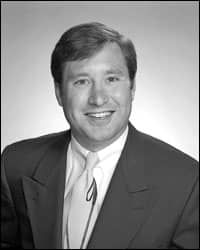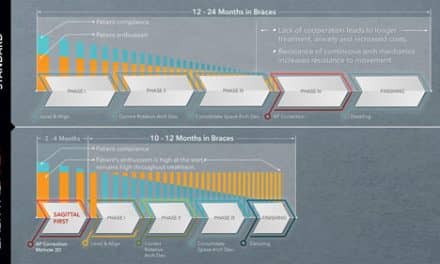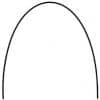by Cory Stephens, DDS, MS
A 21st-century perspective
 |
Personally, I don’t ponder the extraction/nonextraction controversy much in day-to-day practice. I trust my diagnosis and follow the treatment plan that I believe is best for the patient. Although I have just shy of 4 years of clinical experience, I spent 2 years on a thesis that evaluated the long-term profiles of extraction and nonextraction patients, and I have spent more than 3 years in what I consider one of the best clinical orthodontic practices—my father’s. That may sound a little biased, but I believe I have seen long-term results of many methods of treatment, not only in a research atmosphere, but in a successful practice. So, take it for what it is worth, but I just want to offer some of my thoughts on this topic as a 21st-century orthodontist.
 |
| Cory Stephens, DDS, MS |
We all know that early treatment philosophies are very prominent in today’s orthodontic world. In my opinion, early treatment should be a method of treatment that we use to benefit the patient—not to get someone into braces or to say we can treat almost all cases without removing teeth. The reality is that many orthodontic cases, if diagnosed properly, require the extraction of permanent teeth and the initiation of treatment at the proper time in the individual’s development.
I agree that if we start treating every child at 8 or 9 years old and keep them in treatment until their 12-year molars erupt, we could probably treat most cases nonextraction. But, is that the best treatment for the child, and can we treat them successfully? Many studies have shown that, if properly diagnosed and treated, the fact of having two or four premolars removed does not lead to any negative effects long-term.1-3 Stability, aesthetics, and function have all been studied exhaustively on this topic, and the results all show that there is a valid time and place for extraction and nonextraction treatment.
Those who favor nonextraction have often presumed that extraction treatment tends to “dish in” the face; extractionists, on the other hand, often presume the lips tend to be “blown out” by excessive incisor flaring. In actuality, we now have good data that shows that there are only small differences between extraction- and nonextraction-treated patients at the end of treatment.2-5 My study on long-term profile changes in extraction and nonextraction cases also showed very little difference between the two groups, and furthermore, the changes were rarely perceived as positive or negative changes by laypeople or orthodontists.1
I have been privileged to learn from the experience in a practice that has been providing orthodontic treatment for more than 30 years, and in my short career, I have learned that there is a lot more to it than just saying “I take out teeth” or “I don’t.” I believe that the new generation of orthodontists is pressured to treat early and treat nonextraction. In fact, I have seen marketing efforts implying that “our practice treats everybody without removing teeth.” We would all rather not tell a patient that they need to have teeth removed, but the reality is that we are obligated to our patients to render the most stable and healthy treatment available. That means we remove teeth only when we have to, but we are competent enough to know how to diagnose and treat a case regardless of whether we have teeth removed or not.
I do not know the exact percentage of cases we treat extraction versus nonextraction in our practice, but it is important to me that I evaluate every aspect of the case and make the decision whether to remove teeth or not on sound diagnostic parameters, including facial aesthetics as well as the periodontal health and long-term well-being of our patients’ oral health in general.
Palatal expansion and functional appliances are very good treatment modalities—which are often necessary—but again, there is a time and a place. The important thing is that we treat the patient, not necessarily the popular trend. If that means waiting and extracting teeth, then do it; if that means waiting and not extracting teeth, then do it; if that means starting early to help a long-term outcome, then do it.
We can treat cases in many different ways; we just need to stay in tune with making a good, solid diagnosis, and following through with a thorough treatment plan—and most of all, do no harm!
Cory Stephens, DDS, MS, is in private practice in Tyler, Tex. He can be reached at
References
- Stephens CK, Boley JC, Behrents RG, Alexander RG, Buschang PH. Long-term profile changes in extraction and nonextraction patients. Am J Orthod Dentofacial Orthop. 2005;128(4):450-457.
- Paquette DE, Beattie JR, Johnston LE. A long-term comparison of nonextraction and premolar extraction edgewise therapy in “borderline” Class II patients. Am J Orthod Dentofacial Orthop. 1992;102(1):1-14.
- Bishara SE, Cummins DM, Zaher AR. Treatment and posttreatment changes in patients with Class II, Division 1 malocclusion after extraction and nonextraction treatment. Am J Orthod Dentofacial Orthop. 1997;111(1):18-27.
- Bowman SJ, Johnston LE. The esthetic impact of extraction and nonextraction treatment on Caucasian patients. Angle Orthod. 2000;70(1):3-10.
- Zierhut EC, Joondeph DR, Artun J, Little RM. Long-term profile changes associated with successfully treated extraction and nonextraction class II division 1 malocclusions. Angle Orthod. 2000;70(3):208-219.










